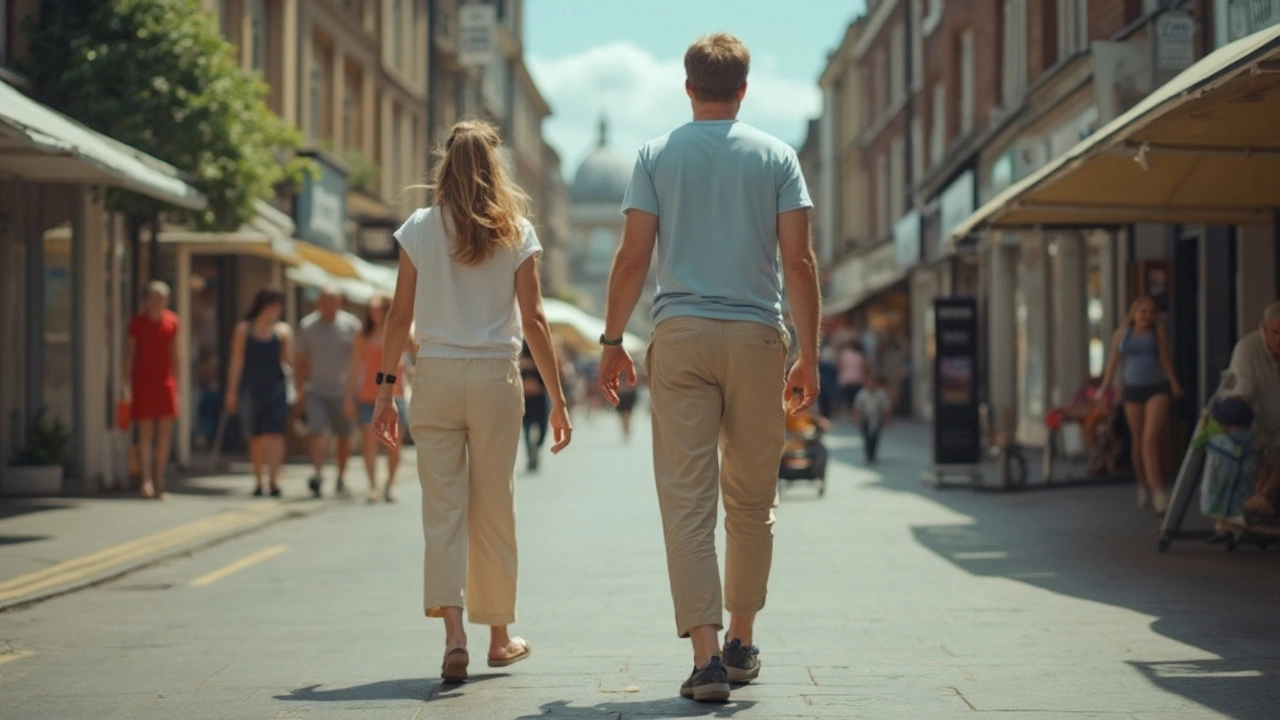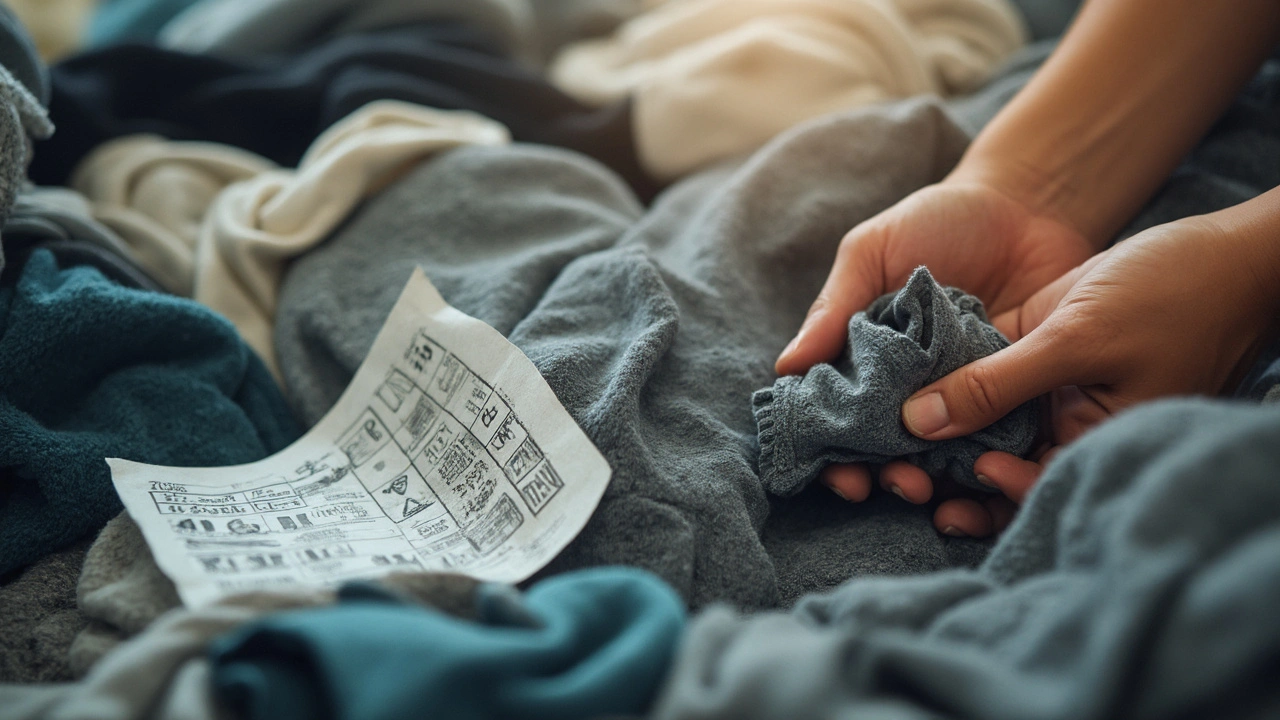Ever had that relentless itch down there after a workout or a hot day? You're not alone. Jock itch is sneaky, but the clothes you pick can make a massive difference—sometimes more than the creams and powders.
Here’s the real deal: fungus thrives in sweat and warmth. So if your boxers, leggings, or shorts trap heat or don’t let your skin breathe, you’re giving jock itch everything it wants to stick around. The right fabrics and fit actually help stop jock itch before it even starts.
Forget running straight to the pharmacy; start by checking your underwear drawer. Some materials hold onto sweat, others wick it away. How you dress after you exercise or shower can mean the difference between feeling fresh and dealing with another flare-up.
- Why Clothes Matter with Jock Itch
- Best and Worst Fabrics for Your Groin
- Smart Clothing Styles to Prevent Irritation
- What to Wear: Gym, Work, and Sleep
- Laundry and Care Tips for Jock Itch Relief
Why Clothes Matter with Jock Itch
If you’re wondering why that itch just won’t stay gone, your clothes could be the main reason. Jock itch—caused by the same type of fungus that brings on athlete’s foot—needs a warm, damp environment to thrive. And guess what? Tight, non-breathable clothing is practically a welcome mat for jock itch.
Sweaty areas stuck under synthetic fabrics keep moisture on your skin longer. Fungus just loves this. According to recent dermatology clinic stats, guys who wear synthetic underwear are up to 40% more likely to deal with regular groin itch compared to those who stick with cotton. That’s a big jump just based on fabric choice.
| Fabric Type | Risk of Jock Itch |
|---|---|
| Synthetic (polyester, nylon) | Higher risk |
| Cotton | Lower risk |
| Moisture-wicking blends | Lowest risk |
It’s not just about fabric, though. Tight underwear, compression shorts, or pants with thick seams can rub and cause micro-abrasions. That’s giving fungus even more reason to stick around since broken skin is easier for it to settle into.
Daily habits matter too. Wearing the same sweaty clothes after a gym session or not swapping underwear often enough gives fungus more time to party. So if you want a real shot at beating jock itch, what you wear (and when you change it) is just as important as any cream from the pharmacy.
Best and Worst Fabrics for Your Groin
If you’re dealing with jock itch or want to stop it before it starts, picking the right fabric can be a game-changer. The idea is simple: keep things dry and cool down there. Certain fabrics do this way better than others.
Let’s start with the best:
- Cotton: Cheap, easy to find, and soft. It lets your skin breathe, but it does soak up sweat and can stay wet. If you’re not super sweaty or you can change often, cotton still works well for everyday wear.
- Moisture-wicking synthetics: Think polyester, nylon blends, or anything labeled as “moisture management.” These fabrics pull sweat off your skin, helping it evaporate. Athletes swear by them for a reason—less wetness means jock itch bacteria and fungi have a tougher time setting up shop.
- Bamboo: Kind of underrated, but bamboo fabric is great at wicking moisture and feels soft, almost like silk. It’s also naturally antimicrobial, which helps cut down on odor and germs.
- Merino wool: Sounds weird for underwear, right? But it’s surprisingly good at handling sweat and fighting stink, plus it doesn’t itch like traditional wool.
Now, watch out for these troublemakers:
- Regular polyester (not moisture-wicking): Feels light but just traps heat and moisture, turning your underwear into a tiny sauna. Skip it unless it’s made for athletic wear.
- Nylon (non-wicking): Same problem as polyester—heat builds up fast, and breathability just isn’t there.
- Silk: Feels fancy but doesn't really help with sweat. It locks in moisture and can boost jock itch risks if you sweat a lot.
- Rayon: Not terrible at first, but quickly gets clammy and holds onto sweat.
Here’s a quick breakdown that’ll help next time you’re shopping for underwear or shorts:
| Fabric Type | Breathability | Moisture Handling | Jock Itch Risk |
|---|---|---|---|
| Moisture-wicking synthetics | High | Excellent | Low |
| Cotton | Good | Decent, but can stay wet | Medium |
| Bamboo | Great | Great | Low |
| Regular polyester/nylon | Poor | Bad | High |
| Silk | Poor | Poor | High |
If you’re ever in doubt, go for something labeled as “moisture-wicking” or “breathable.” Avoid anything thick, non-breathable, or that gets soggy fast. Dry skin is happy skin, especially when you’re fighting jock itch.

Smart Clothing Styles to Prevent Irritation
What you wear below the belt matters more than you think in the battle against jock itch. It’s not just about fabric—style and fit play a role too. Tight, clingy clothes can rub your skin raw and hold in moisture, giving fungus the green light. Instead, go for styles that give you—and your skin—some personal space.
Loose-fitting boxers beat briefs almost every time if you’re prone to jock itch. Boxers let air in and sweat out, so things stay drier. Athletic shorts are great too, but only if they’re made from moisture-wicking fabric and aren’t plastered to your skin. If you need support, pick boxers or briefs labeled as "breathable," which usually means they have mesh panels or are made with quick-drying material.
Pants and shorts matter as well. Skinny jeans or athletic tights look sharp, but they’re not doing your groin any favors if you have recurring issues. Try to save them for cooler days, and definitely avoid wearing them right after a workout or when you’re still damp. If you spend a lot of time sitting (like at a desk job), swap out fitted styles for looser ones to cut back on friction and sweat build-up.
For the gym or sports, compression shorts are popular, but not all of them are created equal. Always check if yours have moisture control features. Here’s a quick comparison you might find handy:
| Style | Risk of Irritation | Best For |
|---|---|---|
| Tight briefs | High | Short periods, not sweaty conditions |
| Loose boxers | Low | Everyday use, sleep, warm weather |
| Compression shorts (moisture-wicking) | Medium | Sports, if changed right after |
The bottom line? Clothes should help your skin breathe, not trap in heat and moisture. Next time you shop for underwear or gym clothes, check for labels like “breathable,” “moisture-wicking,” or “quick-dry.” These little details can make a real difference in preventing jock itch irritation.
What to Wear: Gym, Work, and Sleep
Let’s get into the nitty-gritty: what you throw on for the gym, work, or even just crashing at night really adds up when it comes to jock itch. Think of your clothes as either helping you dodge the itch or making it way easier to catch.
At the gym, your sweat game is strong—so pick gear that’s got your back. Steer clear of cotton underwear; it might feel soft, but it soaks up sweat and holds it right against your skin. Instead, reach for moisture-wicking synthetic fabrics like polyester or nylon blends. Brands even make underwear and shorts with anti-microbial features to ward off fungus. Loose-fitting shorts are better than skin-tight unless the tight stuff is specially made to wick away sweat.
- Moisture-wicking socks and underwear keep sweat away.
- Change out of gym clothes as soon as the workout’s done.
- Make sure everything is dry before re-wearing—wearing damp stuff is just asking for jock itch.
Work clothes are a different story, especially if you’re stuck in them for eight hours straight. If your job is physically active or it’s hot in your workplace, natural fibers like lightweight cotton or bamboo are good bets because they let air in and help sweat evaporate. If you have to wear uniforms, look for ones that breathe and aren’t glued to your skin.
When it’s bedtime, less is more for jock itch prevention. If you’re cool with it, just go commando under loose pajama bottoms or shorts. If that’s not your style, stick with loose, cotton boxers. Heavy pajamas or synthetic fabrics just trap more heat and moisture overnight, giving fungus a free ride.
Need some real-world perspective? Check this out:
| Activity | Best Fabric Choices | What to Avoid |
|---|---|---|
| Gym | Polyester blends, anti-microbial sportswear | Cotton, non-breathable spandex |
| Work | Bamboo, lightweight cotton | Heavy, tight polyester uniforms |
| Sleep | Loose cotton, no underwear | Fleece, snug synthetic pajamas |
If you sweat a lot—whether it’s from hitting the weights or just a tough shift at work—packing an extra pair of underwear to change mid-day is actually a clutch move. Stay dry, pick the right fabrics for every part of your day, and you’ll have a way easier time keeping jock itch at bay.

Laundry and Care Tips for Jock Itch Relief
It’s easy to underestimate how much your laundry game matters when it comes to beating jock itch. Fungus can hang out on your clothes and keep the irritation going if you’re not washing things the right way. Small changes in your laundry routine can knock out those germs before they get a chance to cause trouble.
Start by washing workout gear, underwear, and anything close to your skin after each wear. Don't shove them back in the drawer, thinking you’ll wear them again tomorrow. Those sweat-soaked clothes are a playground for the fungus that causes jock itch.
- Use hot water if your clothes’ care tags allow for it. Hot water kills more fungus than cold or warm cycles.
- Add a bit of white vinegar to your wash to hit bacteria and fungi hard. Just half a cup straight into the drum works.
- Give everything a good dry—skip air-drying if it leaves clothes even a little damp. The dryer on high heat does the best job.
- Separate your sweaty workout gear from regular laundry to stop cross-contamination of fungus and bacteria.
- Change towels often. Using the same damp towel day after day can invite trouble, so toss it in the wash frequently.
If you’re curious how well this works, a 2023 study showed that washing clothes in water above 140°F (60°C) cut the chances of fungus sticking around by more than 75% compared to cold water washes.
For the best results, don’t forget these extra hacks:
- Don’t let dirty laundry pile up in a closed hamper, especially if it’s wet. That sweaty pile is a petri dish.
- If you’ve just had a bad outbreak of jock itch, consider replacing old underwear. Sometimes fungi stick to the fabric even after a wash.
Bottom line: quick, thorough laundry habits mean less fungus hanging around on your clothing—and that’s less itching for you.




